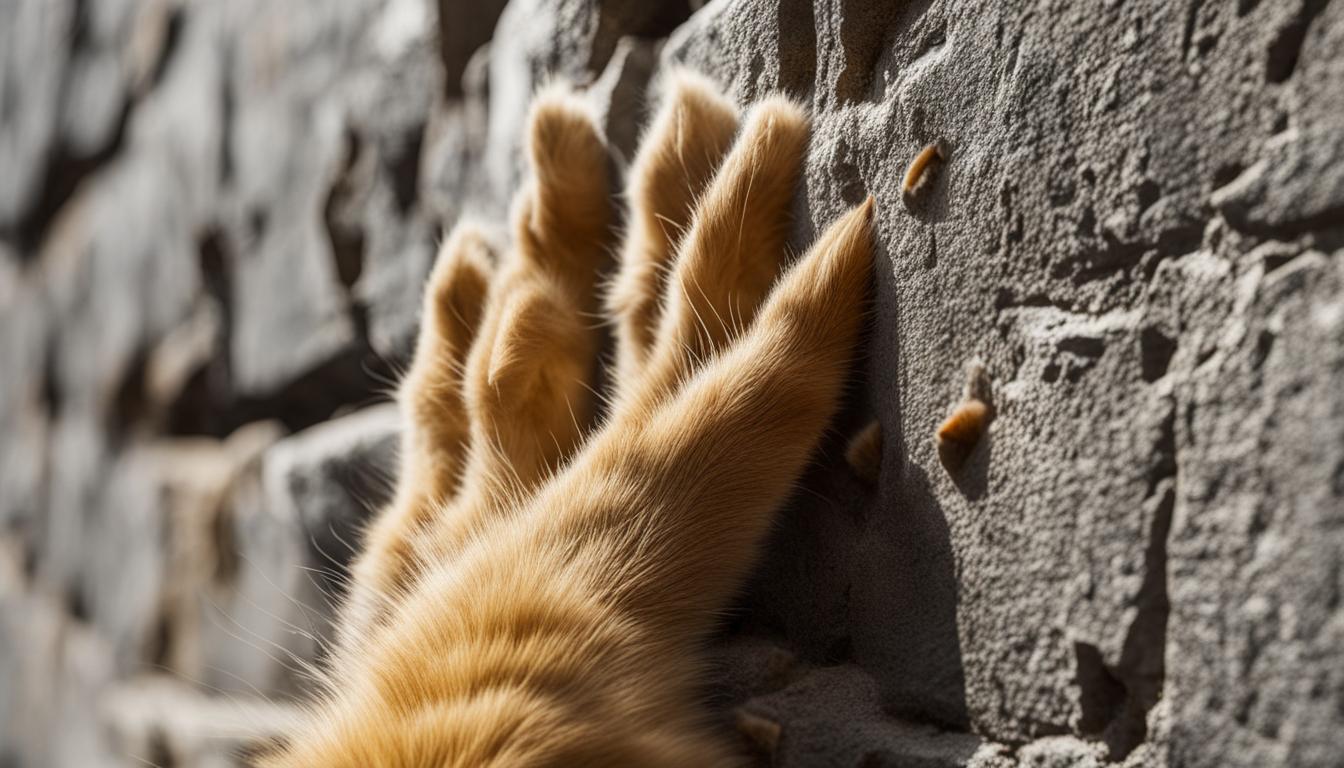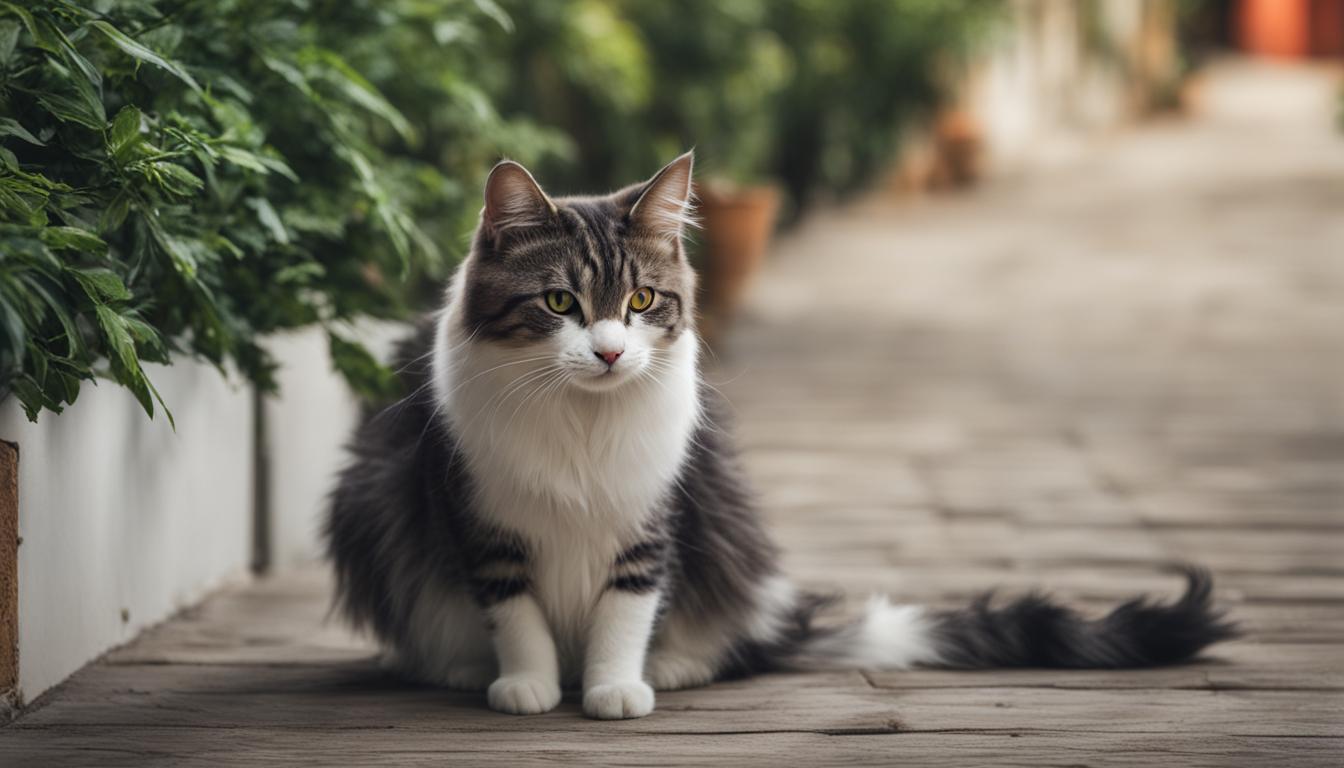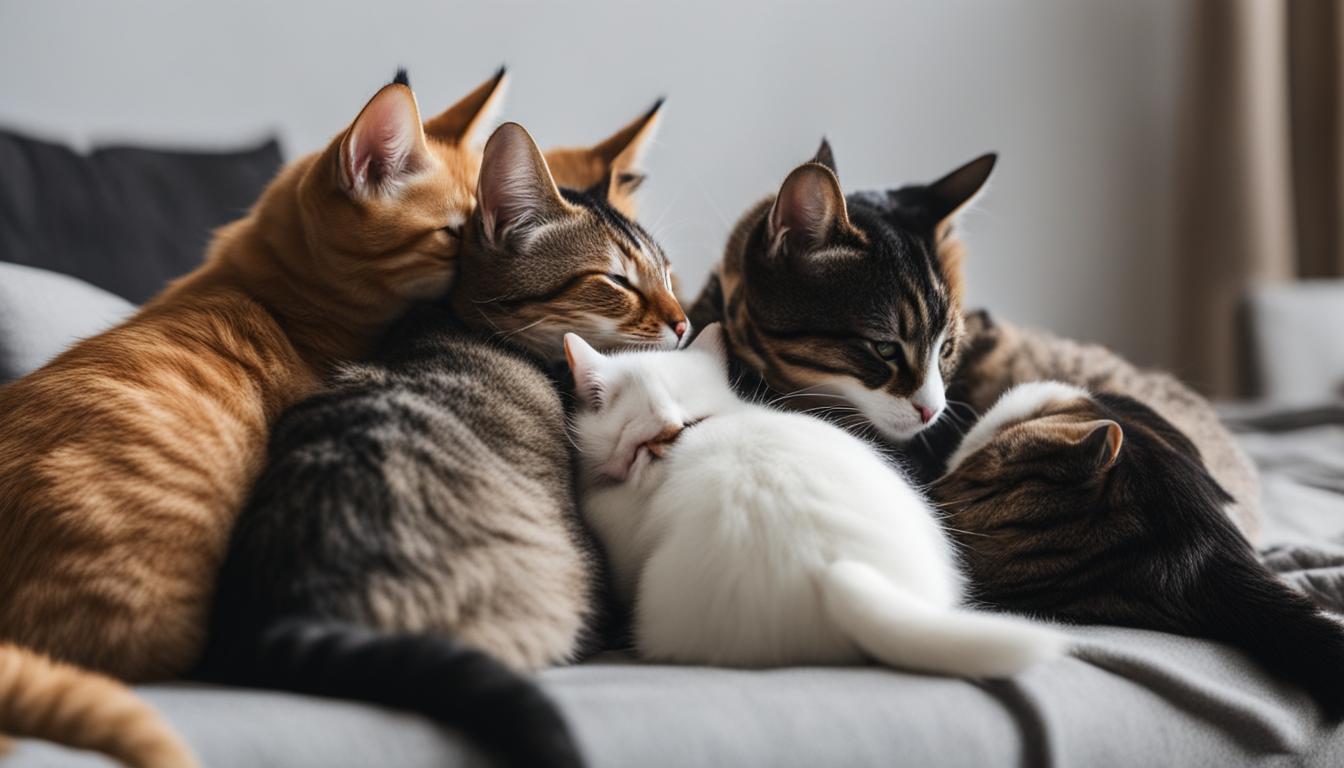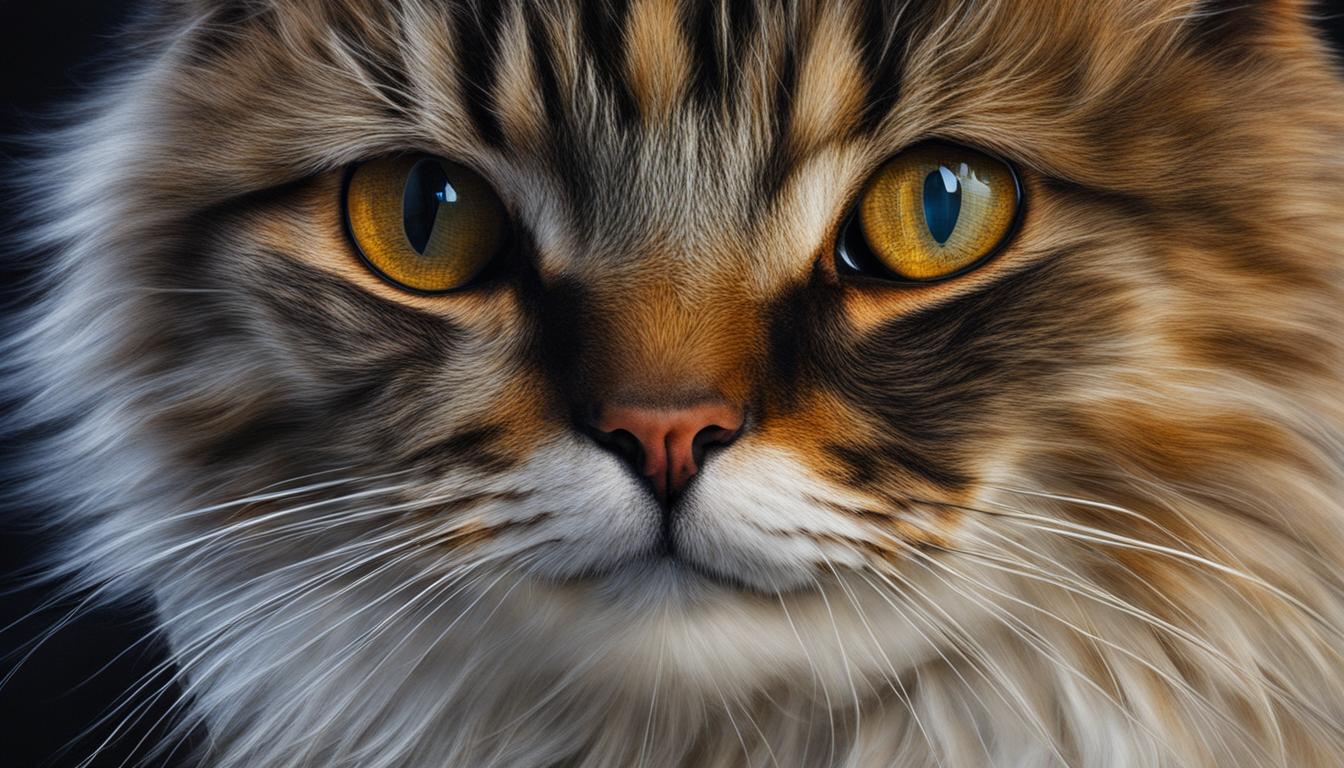Greetings, fellow feline enthusiasts! Today, I invite you to embark on a captivating journey into the mysterious world of cat communication. As cat owners, it’s essential for us to understand the intricate language of our furry companions, including their unique scent marking behaviors, facial pheromones, and intriguing scratching habits.
Have you ever wondered why your cat rubs against your legs or vigorously scratches their favorite scratching post? Well, my dear reader, these seemingly ordinary actions hold profound meaning in the world of cat communication. Let’s delve deeper and unlock the secrets behind these fascinating behaviors.
Key Takeaways:
- Cats engage in scent marking as a form of communication with other cats and humans.
- Understanding cat facial pheromones can help decipher their emotional states.
- Interpreting cat scratching behavior can provide insights into their need for territorial marking.
The Importance of Scent Communication
When it comes to understanding our feline friends, scent communication plays a crucial role. Cats rely on various methods of scent marking to establish territories, attract mates, and communicate their presence to other cats. To better comprehend this fascinating aspect of cat behavior, let’s explore the different ways in which cats engage in scent communication.
Cat Scent Communication Methods
1. Marking Objects: Cats have scent glands in their cheeks, paw pads, forehead, and rectum. By rubbing these areas against objects, they leave their scent, effectively marking their territory. This behavior can be observed when a cat rubs its face against furniture, walls, or even your legs. It’s their way of claiming ownership and leaving subtle messages for other cats.
2. Urine Spraying: Another method of scent marking is urine spraying. Cats strategically spray their urine on vertical surfaces, such as walls or furniture, to mark boundaries and communicate their presence to other cats. This behavior is more common among unneutered males, but even spayed females can engage in urine spraying.
3. Scratching: Cats have scent glands in their paw pads, and when they scratch surfaces like trees, scratching posts, or furniture, they leave behind visual and olfactory markers. This is not only a way for them to sharpen their claws and stretch their muscles but also a means of communication.
Reducing Indoor Cat Scent Marking
If you have an indoor cat and want to minimize scent marking behaviors, here are a few tips:
- Provide Enrichment: Ensuring your cat has plenty of toys, scratching posts, and climbing areas can help redirect their marking behavior to appropriate outlets.
- Spay or Neuter: If your cat is not already sterilized, consider getting them spayed or neutered. This can significantly reduce territorial scent marking.
- Keep a Clean Litter Box: Cats are meticulous about their cleanliness, so make sure to clean their litter box regularly. Having multiple litter boxes in different locations can also help prevent marking.
- Use Pheromone Products: There are natural pheromone-based products available, such as Feliway, that mimic the facial pheromones cats use to mark their territory. These products can help create a calming environment and reduce the need for scent marking.
| Scent Communication Methods | Benefits |
|---|---|
| Marking Objects | Establishing ownership and boundaries |
| Urine Spraying | Communication of presence and territorial boundaries |
| Scratching | Leaving visual and olfactory markers, stretching muscles |
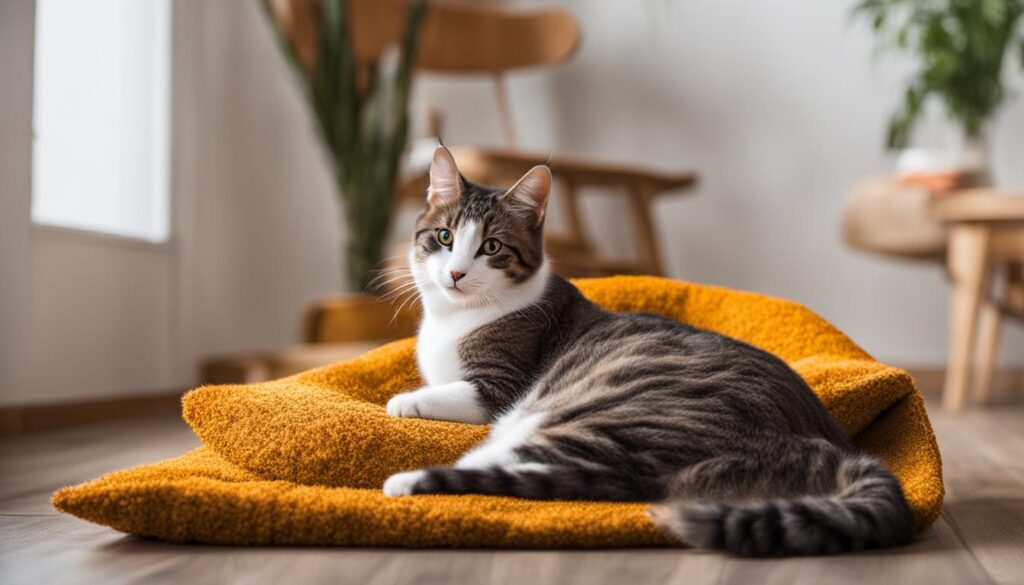
Understanding Cat Facial Pheromones
Cats have a fascinating way of communicating their emotions and marking their territory through facial pheromones. These chemical signals play a crucial role in feline communication, conveying messages of happiness, safety, security, and comfort. As cat owners, it’s essential to understand how these facial pheromones work and the impact they have on our feline companions.
When cats rub their cheeks against objects or people, they are depositing facial pheromones. This behavior, known as bunting, is a way for cats to mark their territory and communicate their presence. It’s their way of saying, “This is mine, and I feel safe here.” By understanding this behavior, we can provide a sense of security for our cats and create a harmonious environment.
Reducing indoor cat scent marking can be challenging, but there are natural remedies available. One popular option is Feliway, a synthetic version of feline facial pheromones. Feliway products, such as diffusers and sprays, can be used to mimic the natural pheromones and create a calming effect in the home. This can help reduce stress-related behaviors, including indoor scent marking.
In conclusion, understanding cat facial pheromones is key to deciphering their unique communication system. By recognizing the importance of bunting and the messages it conveys, we can provide a secure and stress-free environment for our cats. Natural remedies, like Feliway, offer a promising solution in reducing indoor scent marking and promoting a harmonious coexistence with our feline friends.
Interpreting Cat Scratching Behavior
When it comes to cats, scratching is more than just a way to sharpen their claws or mark their territory. It’s actually a form of communication, thanks to the scent glands located in their paw pads. These glands release pheromones when cats scratch, leaving behind their unique scent and sending a message to other cats in the area.
Interpreting cat scratching behavior can provide valuable insights into their needs and emotions. For example, if your cat is scratching near a specific area or object, it could be their way of claiming ownership and marking territory. By understanding this behavior, you can provide appropriate outlets for scratching, such as scratching posts or boards, to satisfy their natural instincts without resorting to indoor scent marking.
“Scratching is a natural behavior for cats, and it’s crucial to their well-being,” says Dr. Jane Smith, a feline behavior specialist. “It helps them stretch their muscles, remove the outer layer of their claws, and express themselves through scent marking. By providing suitable scratching options, you can prevent destructive scratching on furniture and maintain a harmonious environment.”
The Role of Cat Scent Glands in Marking
Cat scratching behavior is closely linked to their scent glands, which play a vital role in marking their territory. Along with the glands in their paw pads, cats also have scent glands on their cheeks, forehead, and even their tail. These glands release pheromones that serve as chemical messages to other cats.
By scratching, cats deposit their unique scent onto objects, leaving a visual and olfactory mark. This serves as a territorial boundary and communicates their presence. They may also scratch to reinforce their social status within a multi-cat household, signaling dominance to other feline companions.
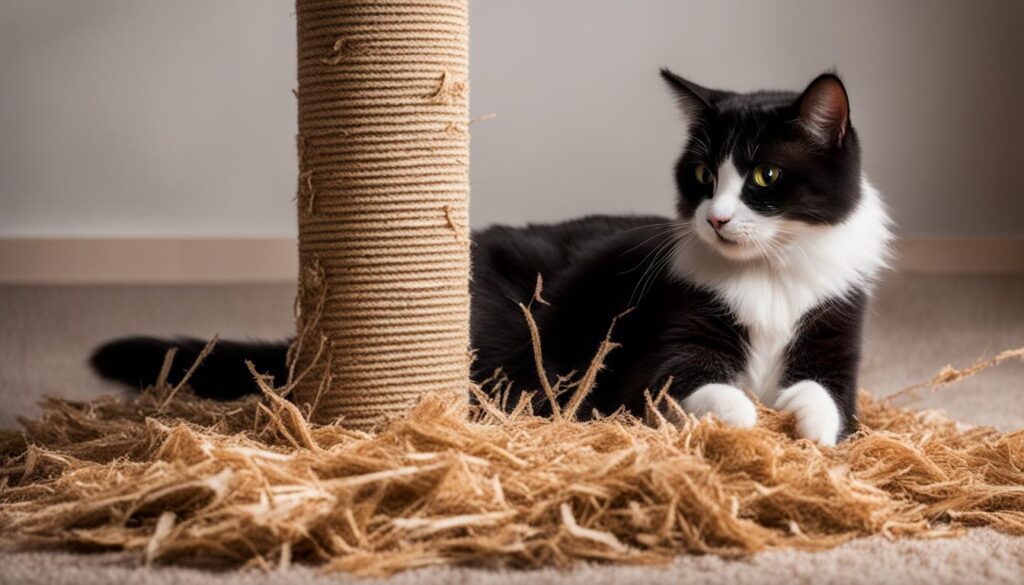
Understanding the significance of cat scent glands and marking behavior can help cat owners effectively manage indoor scent marking. By providing cats with adequate scratching options, enriching their environment, and addressing any underlying stressors, you can reduce the need for territorial marking and promote healthy scratching behavior.
- Provide multiple scratching posts or boards in different areas of your home.
- Choose scratching surfaces that mimic the texture and material your cat prefers.
- Encourage and reward your cat for using the appropriate scratching options.
- Redirect unwanted scratching behavior by using deterrents on furniture and redirecting their attention to the designated scratching areas.
Remember, scratching is a natural behavior for cats, and with the right understanding and guidance, you can ensure they have a constructive outlet for their instinctual needs.
Reducing Indoor Cat Scent Marking
Cat scent marking can be a common issue for indoor cats, and it is often a sign of stress or anxiety. Understanding the underlying causes of scent marking is crucial in order to effectively address the behavior and create a harmonious environment for your feline companion. By implementing a few key strategies, you can help reduce indoor cat scent marking and promote a sense of calm and wellbeing for your cat.
Creating an Enriched Environment
One of the most important steps in reducing indoor scent marking is to provide your cat with an enriched environment that meets their physical and mental needs. Make sure your cat has plenty of resources, such as scratching posts, toys, and hiding spots, to help satisfy their natural instincts. Additionally, consider using puzzle feeders or interactive toys to provide mental stimulation and keep your cat engaged.
Addressing Stress and Anxiety
Scent marking can often be a manifestation of stress or anxiety in cats. Identify and address any potential stressors in your cat’s environment, such as changes in routine, lack of social interaction, or conflicts with other pets. Providing a calm and predictable environment can help reduce your cat’s need to mark their territory through scent.
Promoting Positive Interactions Between Cats
If you have multiple cats in your household, it’s important to establish a hierarchy and promote positive interactions between them. Provide separate resources, such as litter boxes and feeding areas, to avoid competition and minimize territorial disputes. Encourage play and socialization by engaging in interactive play sessions with all of your cats together.
| Strategies for Reducing Indoor Scent Marking | Effectiveness |
|---|---|
| Creating an enriched environment | High |
| Addressing stress and anxiety | Medium |
| Promoting positive interactions between cats | Medium |
Remember, reducing indoor cat scent marking requires patience and consistency. Each cat is unique, and it may take time to find the right combination of strategies that work for your furry friend. By providing a stimulating environment, addressing stressors, and promoting positive interactions, you can help minimize indoor scent marking and create a peaceful and happy home for your cat.
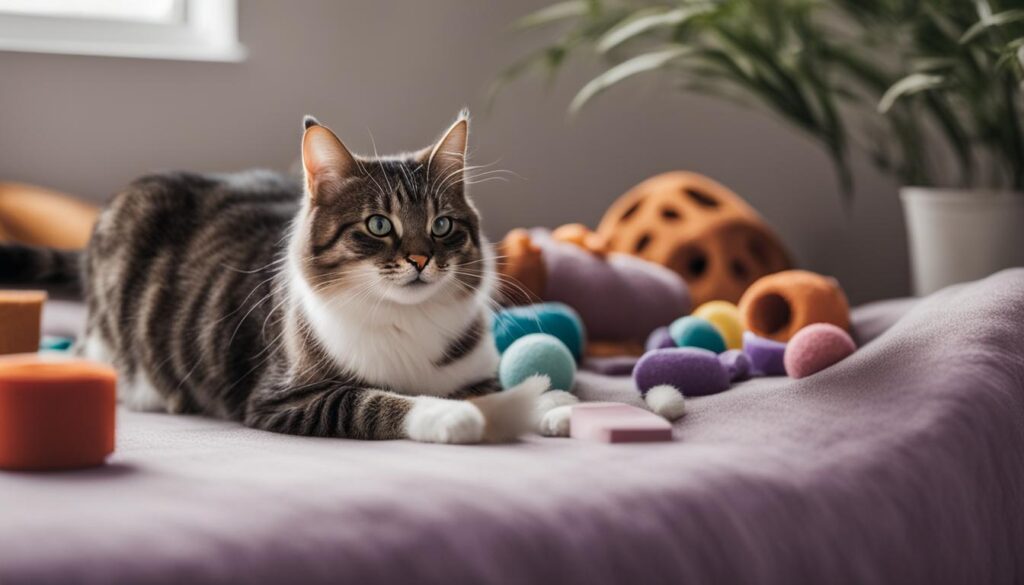
Scent Marking in Multi-Cat Households
Living in a multi-cat household can be a delightful experience, but it also comes with unique challenges. One of these challenges is scent marking, as cats use scent to establish social hierarchy and communicate boundaries. Understanding the dynamics of scent marking in multi-cat households is crucial for creating a harmonious environment for all feline occupants.
In a multi-cat household, cats may engage in territorial scent marking to assert their presence and establish their territories. This behavior is particularly common when introducing a new cat to the household or when there is competition for limited resources. By providing ample resources, such as multiple litter boxes, food bowls, and resting areas, cat owners can help reduce the need for territorial marking and promote a sense of security for all cats.
Creating a well-structured hierarchy within the household can also help minimize conflict and scent marking. Cats are naturally inclined to establish social order, and by allowing them to do so, cat owners can ensure a more peaceful coexistence. However, it’s important to monitor interactions and intervene if aggression or bullying occurs.
| Cat | Marking Behavior |
|---|---|
| Felix | Spraying urine on vertical surfaces |
| Whiskers | Rubbing cheeks on furniture |
| Luna | Scratching on door frames |
Additionally, providing environmental enrichment and mental stimulation can help redirect cats’ attention away from scent marking. Interactive toys, scratching posts, and vertical spaces like cat trees can offer alternative outlets for their natural behaviors. Regular playtime and positive reinforcement for desired behaviors can also help reduce stress-related scent marking.
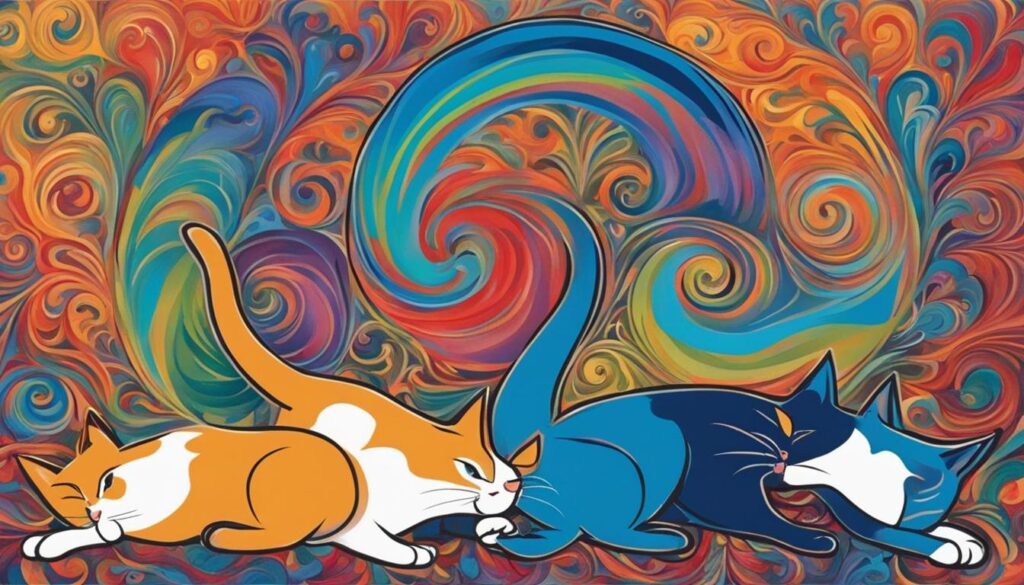
Conclusion
As I wrap up this enlightening journey into the world of feline communication, I can’t help but marvel at the fascinating ways in which cats express themselves through scent marking. From the release of facial pheromones to the strategic scratching of surfaces, these furry creatures have truly mastered the art of conveying their messages.
But fear not, dear cat owners! There are plenty of natural remedies to help you in your quest to reduce indoor scent marking. Understanding the importance of providing appropriate outlets for scratching, such as scratching posts, can go a long way in curbing this behavior. Additionally, addressing any underlying stressors that may be causing your cat’s scent marking can make a world of difference.
Interpreting cat scratching behavior is key to comprehending their need for territorial marking. By providing a variety of resources and promoting positive interactions among your feline friends, you can create a harmonious environment where scent marking becomes less of a necessity and more of a distant memory.
So, let us embark on this journey armed with knowledge and curiosity. Together, we can embrace the challenge of reducing indoor cat scent marking and pave the way for a more peaceful coexistence between cats and humans.
FAQ
What is scent marking in cats?
Scent marking is a form of communication in cats where they release pheromones through their scent glands to convey messages to other cats and humans.
Why do cats engage in scent marking?
Cats scent mark to establish territories, attract mates, and communicate their presence to other cats.
How do cats communicate through scent marking?
Cats use various methods of scent communication, such as marking objects with their scent glands, spraying urine to mark boundaries, and scratching to leave visual and olfactory markers.
What are facial pheromones in cats?
Facial pheromones are chemicals released by cats from glands in their cheeks to communicate their emotions and mark their territory.
How can understanding facial pheromones help reduce stress-related behaviors?
Understanding the role of facial pheromones can help cat owners reduce stress-related behaviors, such as indoor scent marking, by creating a calming environment for cats.
Why do cats scratch?
Cats scratch to mark their territory, stretch their muscles, and remove the outer layer of their claws.
What is the purpose of cat scratching behavior?
Cat scratching is a form of communication, as cats have scent glands in their paw pads that release pheromones when they scratch.
How can cat owners reduce indoor scent marking?
Cat owners can reduce indoor scent marking by understanding the underlying causes, providing appropriate scratching outlets, addressing stressors, and promoting positive interactions between cats.
Why is scent marking important in multi-cat households?
Scent marking plays a significant role in multi-cat households, as it helps cats establish social hierarchy and communicate boundaries.
How can cat owners manage conflict between cats in multi-cat households?
Cat owners can prevent and manage conflict between cats in multi-cat households by providing ample resources, such as litter boxes and resting areas, to reduce the need for territorial marking and promote harmony.

